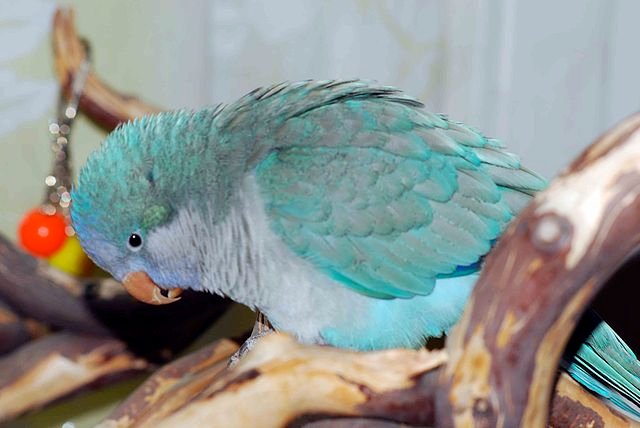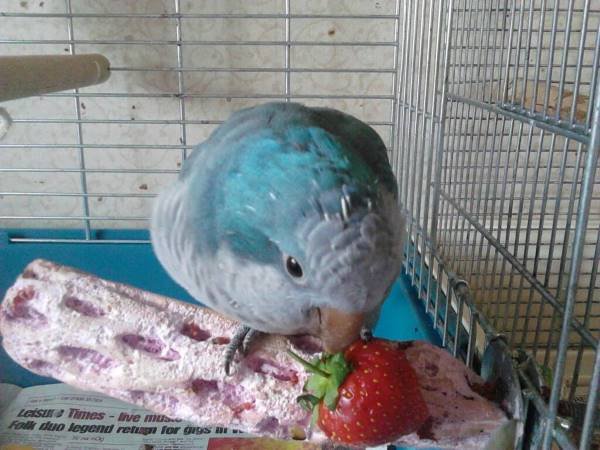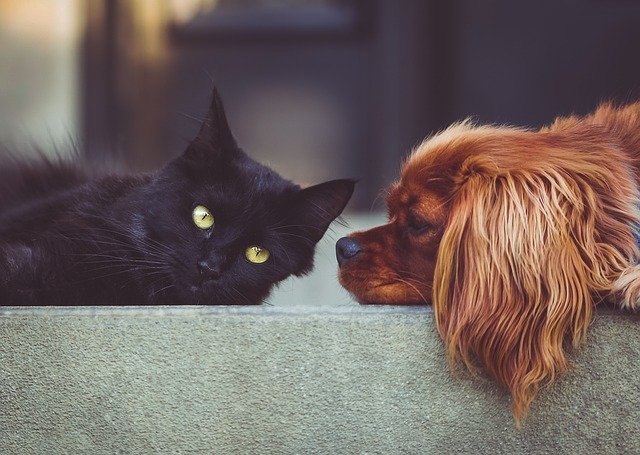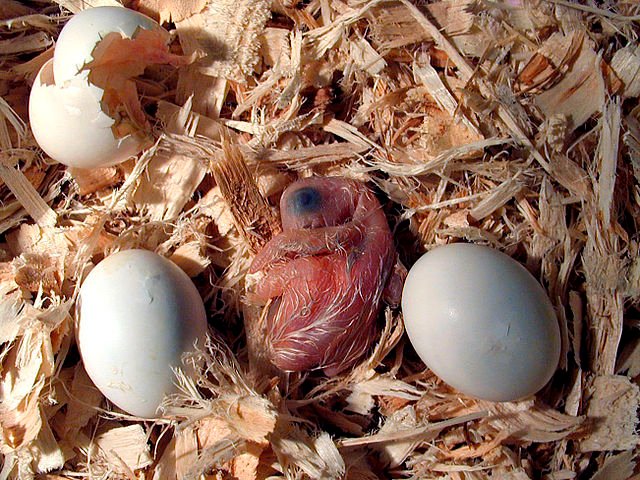A beautiful variation of the original green Quaker parrot, the Blue Quaker parrot came into being by selective breeding of the original species. They soon became the most desired with the color grabbing the fascination of the parrot enthusiasts. Understanding the blue mutation of the Quaker before getting one as a pet is preferred. This can help as a thorough guide for his proper care and thus, keeping him healthy and hearty in the long-term.
For understanding the Blue Quaker parrot information, starting it from the most basic i.e. his origin, name, and size would be quite helpful.
Blue Quaker Parrot Origin
Result of years of successive multiple captive breeding efforts of the original Quaker parrot gave birth to a completely different looking Quaker: the Blue Quaker. Being a little smaller in size than the original green-colored Quaker, the blue mutation was first created in the 1840s by Mr. MJ Bruyneel in Belgium. Scientifically, it is quite a basic mutation to achieve. The green color synthesis in the Quaker is controlled under the process of the Autosomal Recessive Mutation Technique.
The results are:
- No change in the color of paws, claws, beak, and eyes.
- Change in the color of plumage from green to blue.
- Change in the color of the breast from the grey to silver-bluish.
- Feathers change their color gradually after the birth and the blue tint starts to show up on the 16th day from birth.
This successful creation made the Blue Quaker Parrot the most sought after mutation. It got so widespread that it became the most bought genetic Quaker mutation and hence, the most inexpensive one too.
Various names of Blue Quaker Parrot
The scientific name of the Blue Quaker is Myiopsitta Monachus. And when it comes to commonly known Blue Quaker Parrot names, there isn’t just one. These Quakers are known by different names to many.
- Blue Quaker Parakeet
- Blue Monk Parakeet
- Blue Parakeet
- Silver-breasted Parakeet
- Montevideo Blue Parakeet
But Blue Quaker Parrot remains the most famous one hands down.
Physical Attributes
Talking about Blue Quaker Parrot size, being just 11 inches from head to tail, they are a favored bird pet for beginners or for those who do not want to have a large parrot. They have a wingspan of about 48 cm. The female blue Quaker is 10-20% smaller than her male counterpart. The adult blue Quaker is lighter in weight than the original green Quaker. Where the green Quaker weighs approximately 4-5 ounces, the blue one weighs 3.5 ounces on average. But when in the wild, the blue Quaker can grow slightly larger than this and averages 4.4 to 4.9 ounces.

Blue Quaker parrot lifespan ranges from 15 to 25 years. When in the wild, this time period is generally towards the lower limit of the range. And while in captivity, they easily live up to 25 years. But as per the experiences of many blue Quaker owners, they have surpassed this upper limit and has lived for around 30 years also. This feat is not difficult to achieve with proper care, attention, and food for the bird.
Character Attributes
Often called Mini Macaws, Blue Quaker parrots have an independent personality and they don’t bother their owners much to survive. To decide whether to keep Blue Quaker Parrot as a pet or not, knowing all his personality traits are a must to understand his behavior. Blue Quaker parrot personality would involve various aspects which we have tried to cover here.
Behavior
Talking about Blue Quaker parrot behavior, they are extremely social birds. One shouldn’t judge them as a quiet and less talkative parrot seeing their small size. They are an equal of a large parrot in that slender frame. They stay cheerful and chirpy all day long. This is a part of their confident personality.
But sometimes, they can feel a little withdrawn from their environment. This is all an after-effect of an ignored Quaker. If not paid proper attention, these birds are known to become quite aggressive in their behavior. This can lead to stress and depression in them. The condition would need immediate attention if such a case arises.

Talking about behavior, Blue Quakers are also territorial in nature and wouldn’t allow anyone crossing their limits, whether his owner or a companion parrot. Such an attempt makes them extremely aggressive and noisy. They would fight till the intruder is pushed out of their zone.
Temperament
Blue Quaker parrot temperament is a bit relaxed and fun-filled parrot. They are full of life all the time and this is evident from their playful behavior. They never make themselves come across as one of the smallest parrot species as they are high on energy all the time. Being comical is their second nature. They have a unique way of mimicking the sounds they hear around them and make a new version of themselves which adds a lot of natural humor.
Blue Quakers are fond of whistling. They can whistle all day long without getting bored. And this is also their favorite way of remixing the voices around them. But they can get very noisy while doing so. To keep the noise and verbal fun under control, his energy must be directed towards his other favorite activity: playing. A blue Quaker can play on his swing all day long without getting bored. Although a variety of toys is recommended to keep them from getting bored.
Blue Quaker Talking Ability
Quakers have generally an excellent talking ability. But when it comes to the blue ones, they talk a little less than the original green Quakers. Blue Quakers are also weak in learning vocabulary and phrases. Their thesaurus would have a little less words as expected of a Quaker. But that doesn’t mean that they can’t learn it at all or they talk any less than any other parrot. They talk a lot.
Blue Quakers like to copy voices they hear around them and hence, are extremely good at mimicking sounds. Once they hear something around them, they start practicing it in isolation until they feel they are perfect enough to say it out aloud. Though they would need to be trained just like other parrots to form words and then phrases. That needs a dedicated time of the Blue Quaker owner. Here’s a video of a Blue Quaker Parrot exhibiting his talking ability.
A Guide to Raise Blue Quaker Parrot
Finalizing blue Quaker parrot for adoption as a pet would require one to know his basic physical and behavioral attributes. But taking an informed decision is surely not the last step. It is just the beginning of a series of new tasks on hand. From deciding the gender and exact blue color tone of the Quaker to getting the appropriate cage for him, from taking care of his diet to buying the most appropriate toys for him, from imparting proper training to him to handling his biting issues, the list is endless. Let’s understand all the do’s and dont’s.
Deciding the purpose of adopting
Blue Quaker parrot breeding has reached new heights in recent years with breeders successfully coming out with many variations in the blue Quaker tone alone. This has got blue Quaker lovers as well as breeders interested alike in all the options they can have. Once the blue color has been finalized, the selection of its further mutation depends upon the purpose for which the bird is being bought.
- Blue Quaker parrot lovers around the world are known to buy the most basic mutation of blue Quaker which also happens to be the most popular one. Since, the other mutations are rarer and costlier to have, if the sole purpose of having a blue Quaker is a fascination with the unique colored parrot, the most common available blue Quaker would certainly solve the purpose.
- Blue Quakers parrots are quite in demand among the breeding community as this is how they keep creating new colors. Selective breeding with the sole aim of creating more fresh and never-seen-before colors has made blue Quakers much in demand in recent times. Two of the breeders’ favorite color tones, as research, are:
a) Dark Blue Quaker Parrot – The color of this series is a concrete greyish-blue tone. Since most of their mutations are from single factor, not all of them can breed chicks. But if the purpose is to keep them as pets only without reproduction, they are a great choice.
a) Cobalt Blue Quaker Parrot – The color of this series is a dark purplish-blue tone. Since they are also produced from mostly single factor selective breeding, they lack the ability to breed all the chicks.
Ascertaining cost
As much as all say ‘cost doesn’t matter’, the fact is that it does. Although the most inexpensive color mutation in the world, the blue Quaker parrot cost is still quite high, at least as compared to the original green Quakers. Whereas a green Quaker can cost approximately $150 going up to $400 depending upon the breeder, the Blue Quaker parrot cost is much higher and mostly costs between $700 with the rarer colors fetching up to $1200 even for a blue quaker parrot baby.
Selecting the gender
Almost always ignored by most of the pet owners, selecting the gender of the bird is helpful in many cases. If one is a beginner and doesn’t know how to deal with a Quaker, dealing with chicks later can lead to frustration both for the owner and the whole brood. If one has a busy lifestyle and can take out time to give proper care to a single bird, even a single extra bird can make him feel burdened leading to the sufferings of all the birds. Hence, if the breeding issue is not a problem, selecting a blue quaker parrot male or female won’t make a difference.
Knowing the gender of Blue Quaker can’t be done just by physically looking at the bird. Some people base their determination looking at the color of the neck of the bird but it is a wrong way and a failure too. If someone gets it right this way, it’s nothing more than a hit and trial method. Do not fall for the trap.
There are only two ways that are accurate as they are scientifically approved. The first one is DNA testing method and the other is the surgical sexing of the Quaker. For carrying out any of the tests on the bird, taking him to the avian vet is a prerequisite.
Finally, once the blue Quaker of choice has been finalized, don’t forget to make sure if he’s been tested for various possible bird diseases such as Psittacine Beak and Feather Disease (PBFD), Polyoma or Avian Borna Virus. This will ensure that the Quaker one is finally adopting is perfectly healthy.
Blue Quaker Parrot Care at Home
Once Blue quaker parrot baby has been adopted as a pet and brought home, the major task of taking his care starts. This involves many aspects to be looked after. And for the convenience of understanding them well, each has been discussed one by one separately.
Taking care of blue Quaker parrot baby
When a baby parrot is brought home, handling him is quite different from that of an adult parrot. As against the cage, he needs a box to live in. One can make that cage at home with any cardboard box. It is similar to the house in which kittens and puppies are kept in their initial months. The height of the breeding box should be at least 14 inches as baby Quakers are known to jump out of the box as they start growing. No cage accessories or toys are required to be kept inside for the bird as he is too small to play yet.
More info on Quaker parrot baby care https://parrotquaker.com/how-to-take-care-of-quaker-parrot-babies/
If a homemade cardboard type of cage is being used, do not forget to insulate the cage from the bottom by making a layer of litter or twigs and wood shavings. This is because baby Quakers are quite sensitive to fluctuating temperatures and the extreme drop in temperatures have been proved to be fatal to them. Using a source to heat baby Quaker’s cage is also a must. Heating pads and infrared heating lamps or bulbs of 250 watts are the two best ways of providing warmth. Using a lamp with a red bulb instead of white is important as the white light interferes with Quaker’s sleeping patterns. Taking extra care of them during their infant days is necessary.
Blue Quaker parrot food as a baby has to be kept as advised by the breeder. And generally, food in the form of a pre-mix is available in the market, especially for Blue baby Quakers. It is only after his infancy is over, the pre-mixed food should be supplemented with fresh fruits and vegetables.
Taking care of Blue Quaker Parrot Adult
When the blue Quaker parrot enters the stage of adulthood, his needs also change. He can no longer be kept in the breeder box or be fed a pre-mixed market diet. With age, he will start showing his personality traits. Hence, he’ll have to be trained just like any other pet.
Blue Quaker Diet
The first thing to do, when blue Quaker enters into adulthood, is shifting their diet from baby food to a full-fledged one. Blue Quaker parrot diet should always be a mix of nuts and seeds and fresh fruits and vegetables. A colorful diet including peppers, root vegetables, and nuts is a key to blue Quaker’s good health.

Overdoing any of it can have its own effects, say, blue Quaker high on nuts and low on leafy greens can become obese. So a perfect balance of both must be fed.
When any blue Quaker transitions from infancy to adulthood, providing him an appropriately sized cage is a necessity. The cage should be at least 18 inches in length, breadth, and height. The bigger the cage, the better it is, as Quakers need space to move around and play and also to start taking short flights. There are many varieties of blue Quaker parrot cages available in the market or online portals.
Young blue Quaker is always high on energy and hormones. There is a need to channelize his energy otherwise he might get aggressive and training plays the most role in it. The first thing one will notice in an overtly active Quaker will be biting. Blue Quaker parrot biting can only be tackled with time and patience. In most cases, diverting their efforts to playing helps. Provide the Quaker with enough toys in the cage and he’ll get something to chew upon.
Raising a Quaker would also need to train him for pooping, bathing, grooming and such other routine activities. Blue Quaker parrot training should start from the day the owner has struck a comfort level with him. A close bond is a must to train him. Just like other pets, blue Quaker should also be trained for pooping at the right place, taking a bath, learning words and phrases and all such disciplinary actions. It takes time but success depends only on the patience level of the owner.
Blue Quaker Parrot Facts
Before keeping a blue Quaker parrot as pets, the owners must get some of the quick facts about these birds clear to bust all the myths surrounding them.
- Blue Quaker parrots aren’t a different species or subspecies of Quakers. They are only a color mutation of the original green Quakers.
- Blue Quakers aren’t a carbon copy of green Quakers in behavior and traits. As they both carry different genes, their traits vary, although slightly.
- Blue Quakers came into being in the19th century as against the popular notion that they started existing only at the end of the 20th century.
- Apart from the obvious color change, the physical traits of a blue Quaker also differ from that of his parent breed.



